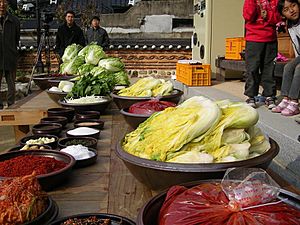Gimjang facts for kids
| Gimjang | |

Preparing for gimjang: ingredients to make kimchi on a larger scale
|
|
Quick facts for kids Korean name |
|
|---|---|
| Hangul | |
| Revised Romanization | Gimjang |
| McCune–Reischauer | Kimjang |
Gimjang (김장), also known as kimjang, is a special Korean tradition. It's all about making and saving lots of kimchi for the winter. Kimchi is a famous spicy Korean dish made from fermented vegetables.
During warmer months, people make kimchi fresh, using vegetables that are ready to harvest. But for winter, families get together for about a month, usually starting in October. They prepare huge amounts of kimchi. This way, they have plenty of healthy food to eat all winter long.
Gimjang is so important that UNESCO recognized it in 2013. It's listed as an Intangible Cultural Heritage. This means it's a valuable tradition that should be protected and passed down. It's also the 133rd Korean Intangible Cultural Property in South Korea.
What is Gimjang?
Gimjang is more than just making food; it's a big part of Korean culture. Kimchi can be eaten with almost any meal. People have been making kimchi for a very long time, since at least the 1200s! Back then, it was made with vegetables, pickles, and salt. Red pepper, which gives kimchi its famous spice, was added later in the 1600s.
Today, kimchi is usually made from napa cabbage and white radish. But there are hundreds of different types! Some kimchi might also have turnip, leek, carrots, or garlic.
The Gimjang Process
When the weather gets cooler in November, many fresh vegetables are ready in the fields and markets. This is when the Gimjang process begins. Making kimchi for winter is a lot of work, so families, relatives, and neighbors all help each other.
Groups of Korean people gather to:
- Cut the vegetables.
- Wash them carefully.
- Add salt to cure the food. Curing helps to preserve the vegetables and starts the fermentation process. Fermentation is when tiny living things (like good bacteria) change the food, making it last longer and giving it a special flavor.
Storing Kimchi
Storing kimchi for a long time can be tricky. If it gets too cold, it will freeze. If it gets too warm, it will ferment too much and might turn sour.
In the past, before we had modern refrigerators, people had a clever way to store kimchi. They would put it in special earthenware jars. These jars were then buried in the ground, sometimes up to their necks! This kept the kimchi from freezing in the winter. When the temperature dropped below freezing, the fermentation would stop, keeping the food fresh. As spring arrived and temperatures rose, the fermentation would start again.
Gimjang Today
Even with modern refrigerators, the tradition of Gimjang is still very strong. Many families continue to make kimchi together, passing down the skills from older generations to younger ones.
Kimchi has a strong smell, which can sometimes make other foods in a regular refrigerator smell like kimchi. Because of this, it's common for people in cities to store large jars of fermenting kimchi on their balconies. Also, many Korean homes now have special refrigerators just for storing kimchi! These kimchi refrigerators keep the kimchi at the perfect temperature for long-term storage.
Even though it's easy to buy kimchi made in factories these days, the Gimjang tradition is still important. To help people learn about this special custom, Seoul has a unique kimchi museum. Here, visitors can try different kinds of kimchi and learn all about the traditional Gimjang process. Koreans still eat a lot of kimchi, about 25 kilograms (55 pounds) per person each year!

